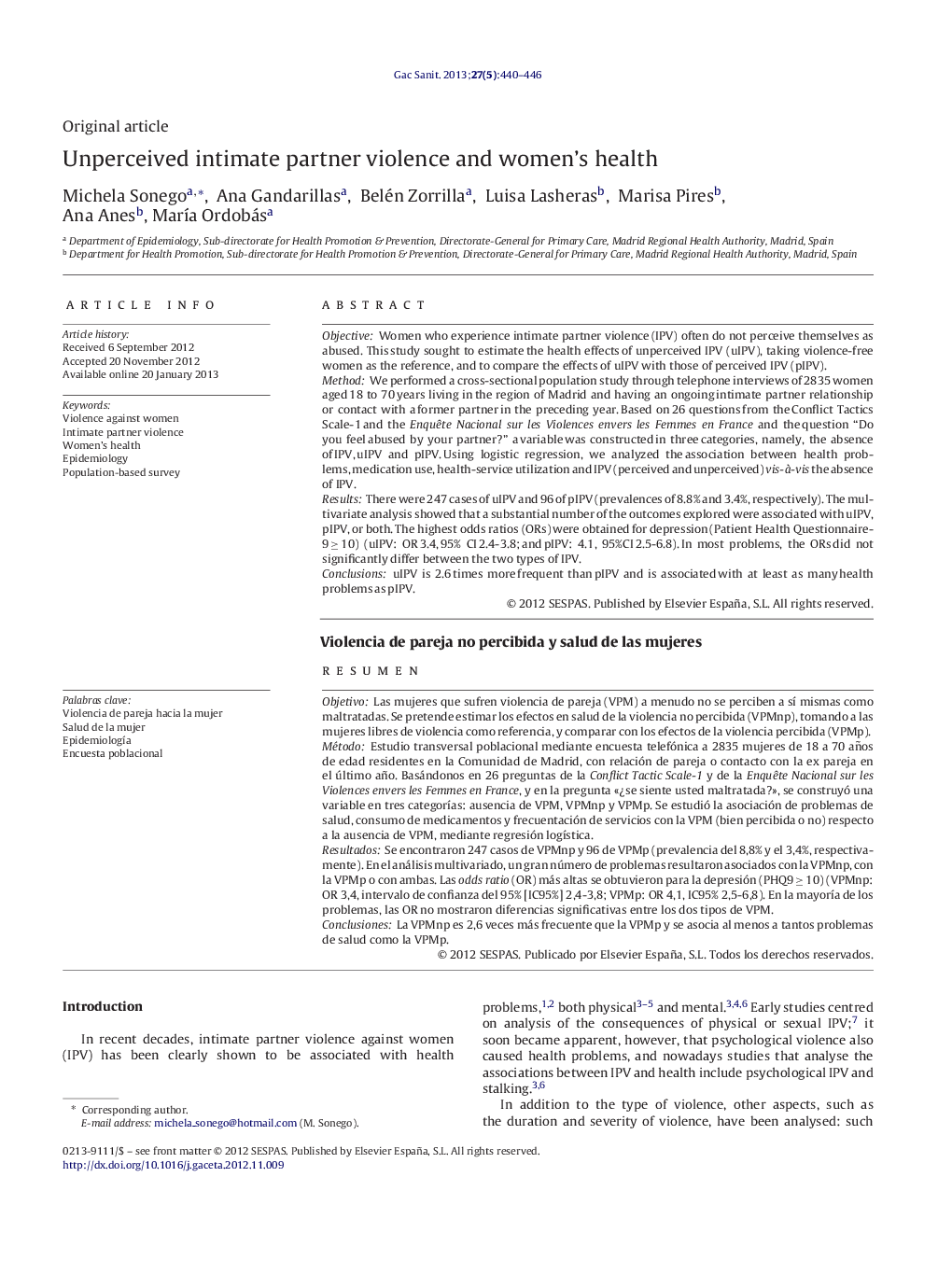| کد مقاله | کد نشریه | سال انتشار | مقاله انگلیسی | نسخه تمام متن |
|---|---|---|---|---|
| 1073199 | 949777 | 2013 | 7 صفحه PDF | دانلود رایگان |

ObjectiveWomen who experience intimate partner violence (IPV) often do not perceive themselves as abused. This study sought to estimate the health effects of unperceived IPV (uIPV), taking violence-free women as the reference, and to compare the effects of uIPV with those of perceived IPV (pIPV).MethodWe performed a cross-sectional population study through telephone interviews of 2835 women aged 18 to 70 years living in the region of Madrid and having an ongoing intimate partner relationship or contact with a former partner in the preceding year. Based on 26 questions from the Conflict Tactics Scale-1 and the Enquête Nacional sur les Violences envers les Femmes en France and the question “Do you feel abused by your partner?” a variable was constructed in three categories, namely, the absence of IPV, uIPV and pIPV. Using logistic regression, we analyzed the association between health problems, medication use, health-service utilization and IPV (perceived and unperceived) vis-à-vis the absence of IPV.ResultsThere were 247 cases of uIPV and 96 of pIPV (prevalences of 8.8% and 3.4%, respectively). The multivariate analysis showed that a substantial number of the outcomes explored were associated with uIPV, pIPV, or both. The highest odds ratios (ORs) were obtained for depression (Patient Health Questionnaire-9 ≥ 10) (uIPV: OR 3.4, 95% CI 2.4-3.8; and pIPV: 4.1, 95%CI 2.5-6.8). In most problems, the ORs did not significantly differ between the two types of IPV.ConclusionsuIPV is 2.6 times more frequent than pIPV and is associated with at least as many health problems as pIPV.
ResumenObjetivoLas mujeres que sufren violencia de pareja (VPM) a menudo no se perciben a sí mismas como maltratadas. Se pretende estimar los efectos en salud de la violencia no percibida (VPMnp), tomando a las mujeres libres de violencia como referencia, y comparar con los efectos de la violencia percibida (VPMp).MétodoEstudio transversal poblacional mediante encuesta telefónica a 2835 mujeres de 18 a 70 años de edad residentes en la Comunidad de Madrid, con relación de pareja o contacto con la ex pareja en el último año. Basándonos en 26 preguntas de la Conflict Tactic Scale-1 y de la Enquête Nacional sur les Violences envers les Femmes en France, y en la pregunta «¿se siente usted maltratada?», se construyó una variable en tres categorías: ausencia de VPM, VPMnp y VPMp. Se estudió la asociación de problemas de salud, consumo de medicamentos y frecuentación de servicios con la VPM (bien percibida o no) respecto a la ausencia de VPM, mediante regresión logística.ResultadosSe encontraron 247 casos de VPMnp y 96 de VPMp (prevalencia del 8,8% y el 3,4%, respectivamente). En el análisis multivariado, un gran número de problemas resultaron asociados con la VPMnp, con la VPMp o con ambas. Las odds ratio (OR) más altas se obtuvieron para la depresión (PHQ9 ≥ 10) (VPMnp: OR 3,4, intervalo de confianza del 95% [IC95%] 2,4-3,8; VPMp: OR 4,1, IC95% 2,5-6,8). En la mayoría de los problemas, las OR no mostraron diferencias significativas entre los dos tipos de VPM.ConclusionesLa VPMnp es 2,6 veces más frecuente que la VPMp y se asocia al menos a tantos problemas de salud como la VPMp.
Journal: Gaceta Sanitaria - Volume 27, Issue 5, September–October 2013, Pages 440–446